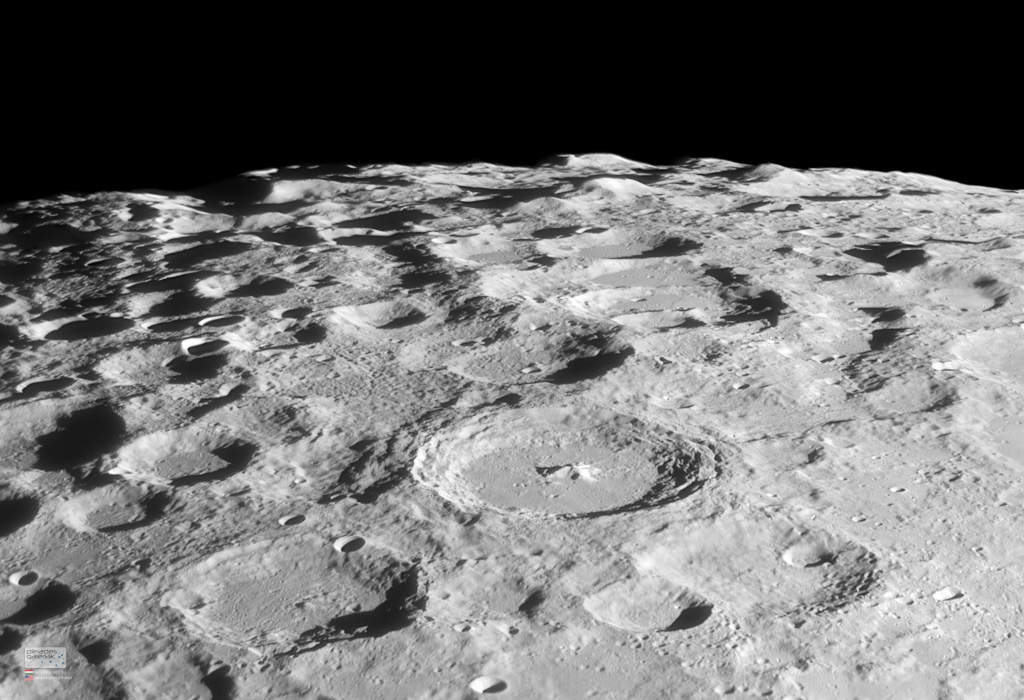30. August 2024
月球南極 ê 景色

探索宇宙1!逐工會揀一幅無仝款 ê 影像抑是相片,𤆬你熟似咱這个迷人 ê 宇宙,閣有專業天文學者2為你3解說4。
- 原始文章:Southern Moonscape
- 影像來源 kah 版權:Lorand Fenyes
- 台文翻譯:An-Li Tsai (NSYSU)
[漢羅] 月球南極 ê 景色
這是一張用 望遠鏡翕--ê 詳細月球景色。 相片倒爿頂懸,是 月球 ê 南極。 這是 8 月 23 翕--ê,翕--ê 是 敧敧曲曲 ê 月球南部高地。 因為透視角度 ê 關係,隕石坑 看起來是密喌喌,而且愈倚月球邊緣,隕石坑看起來就愈扁。 中央附近 上大彼个是 Moretus 隕石坑,直徑 是 114 公里。 Moretus 隕石坑是 月球頂懸一个大型 ê 少年隕石坑。 伊有 樓梯型 ê 內底壁,坑底 ê 山尖有 2.1 公里懸。 看起來 kah 較倚北爿 ê 少年隕石坑 Tycho 有成。 相片頂懸是月球邊緣 ê 山脈,差不多有 6 公里懸。 月球南極附近是 永暗區 ê 隕石坑坑底,照講,這應該是水冰 ê 冰庫。 所以這个敧敧曲曲 ê 月球南極 就變做是一个 足有名 ê 探險區。
[POJ] Goe̍h-kiû Lâm-ke̍k ê Kéng-sek
Che-sī chi̍t-tiuⁿ iōng bōng-oán-kiàⁿ hip--ê siông-sè Goe̍h-kiû kéng-sek. Siòng-phìⁿ tò-pêng téng-koân, sī Goe̍h-kiû ê lâm-ke̍k. Che-sī 8 goe̍h 23 hip--ê, hip--ê sī khi-khi-khiau-khiau ê Goe̍h-kiû lâm-pō͘ ko-tē. In-ūi thàu-sī kak-tō͘ ê koan-hē, ún-se̍k-kheⁿ khòaⁿ-khí-lâi sī ba̍t-chiuh-chiuh,jî-chhiáⁿ jú óa Goe̍h-kiû pian-iân,ún-se̍k-kheⁿ khòaⁿ-khí-lâi tō jú píⁿ. tiong-ng hù-kīn siōng-tōa hit-ê sī Moretus ún-se̍k-kheⁿ,ti̍t-kèng sī 114 kong-lí. Moretus ún-se̍k-kheⁿ sī Goe̍h-kiû téng-koân chi̍t-ê tōa-hêng ê siàu-liân ún-se̍k-kheⁿ. I ū lâu-thui hêng ê lāi-té piah,kheⁿ té ê soaⁿ-chiam ū 2.1 kong-lí koân. khòaⁿ-khí-lâi kah khah óa pak-pêng ê siàu-liân ún-se̍k-kheⁿ Tycho ū sêng. siòng-phìⁿ téng-koân sī Goe̍h-kiû pian-iân ê soaⁿ-me̍h,chha-put-to ū 6 kong-lí koân. Goe̍h-kiû lâm-ke̍k hù-kīn sī éng àm khu ê ún-se̍k-kheⁿ kheⁿ-té, chiàu-kóng, che eng-kai sī chúi-peng ê peng-khò͘. Só͘-í chit-ê khi-khi-khiau-khiau ê Goe̍h-kiû lâm-ke̍k to̍h piàn-chò sī chi̍t-ê chiok ū-miâ ê thàm-hiám-khu.
[KIP] Gue̍h-kiû Lâm-ki̍k ê Kíng-sik
Tse-sī tsi̍t-tiunn iōng bōng-uán-kiànn hip--ê siông-sè Gue̍h-kiû kíng-sik. Siòng-phìnn tò-pîng tíng-kuân, sī Gue̍h-kiû ê lâm-ki̍k. Tse-sī 8 gue̍h 23 hip--ê, hip--ê sī khi-khi-khiau-khiau ê Gue̍h-kiû lâm-pōo ko-tē. In-uī thàu-sī kak-tōo ê kuan-hē, ún-si̍k-khenn khuànn-khí-lâi sī ba̍t-tsiuh-tsiuh,jî-tshiánn jú uá Gue̍h-kiû pian-iân,ún-si̍k-khenn khuànn-khí-lâi tō jú pínn. tiong-ng hù-kīn siōng-tuā hit-ê sī Moretus ún-si̍k-khenn,ti̍t-kìng sī 114 kong-lí. Moretus ún-si̍k-khenn sī Gue̍h-kiû tíng-kuân tsi̍t-ê tuā-hîng ê siàu-liân ún-si̍k-khenn. I ū lâu-thui hîng ê lāi-té piah,khenn té ê suann-tsiam ū 2.1 kong-lí kuân. khuànn-khí-lâi kah khah uá pak-pîng ê siàu-liân ún-si̍k-khenn Tycho ū sîng. siòng-phìnn tíng-kuân sī Gue̍h-kiû pian-iân ê suann-me̍h,tsha-put-to ū 6 kong-lí kuân. Gue̍h-kiû lâm-ki̍k hù-kīn sī íng àm khu ê ún-si̍k-khenn khenn-té, tsiàu-kóng, tse ing-kai sī tsuí-ping ê ping-khòo. Sóo-í tsit-ê khi-khi-khiau-khiau ê Gue̍h-kiû lâm-ki̍k to̍h piàn-tsò sī tsi̍t-ê tsiok ū-miâ ê thàm-hiám-khu.
[English] Southern Moonscape
The Moon's south pole is toward the top left of this detailed telescopic moonscape. Captured on August 23, it looks across the rugged southern lunar highlands. The view's foreshortened perspective heightens the impression of a dense field of craters and makes the craters themselves appear more oval shaped close to the lunar limb. Prominent near center is 114 kilometer diameter crater Moretus. Moretus is young for a large lunar crater and features terraced inner walls and a 2.1 kilometer high, central peak, similar in appearance to the more northerly young crater Tycho. Mountains visible along the lunar limb at the top can rise about 6 kilometers or so above the surrounding terrain. Close to the lunar south pole, permanently shadowed crater floors with expected reservoirs of water-ice have made the rugged south polar region of the Moon a popular target for exploration.
詞彙學習
| 漢羅 | POJ | KIP | 華語 | English |
|---|---|---|---|---|
| 南極 | lâm-ke̍k | lâm-ki̍k | 南極 | south pole |
| 高地 | ko-tē | ko-tē | 高地 | highlands |
| 隕石坑 | ún-se̍k-kheⁿ | ún-si̍k-khenn | 隕石坑 | crater |
| 永暗區 | éng-àm-khu | íng-àm-khu | 永夜區 | permanently shadowed |
| 水冰 | chúi-peng | tsuí-ping | 水冰 | water-ice |
| 冰庫 | peng-khò͘ | ping-khòo | 冰庫 | ice reservoirs |